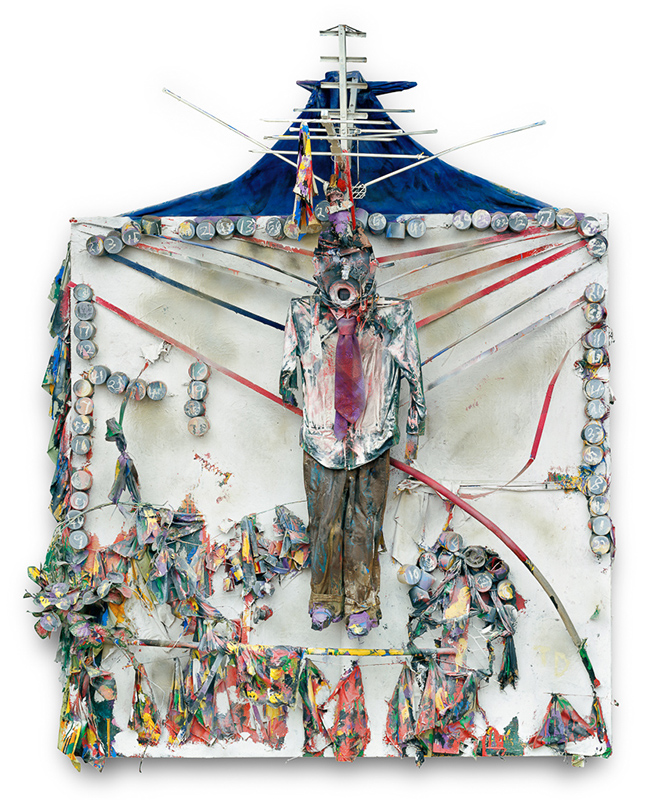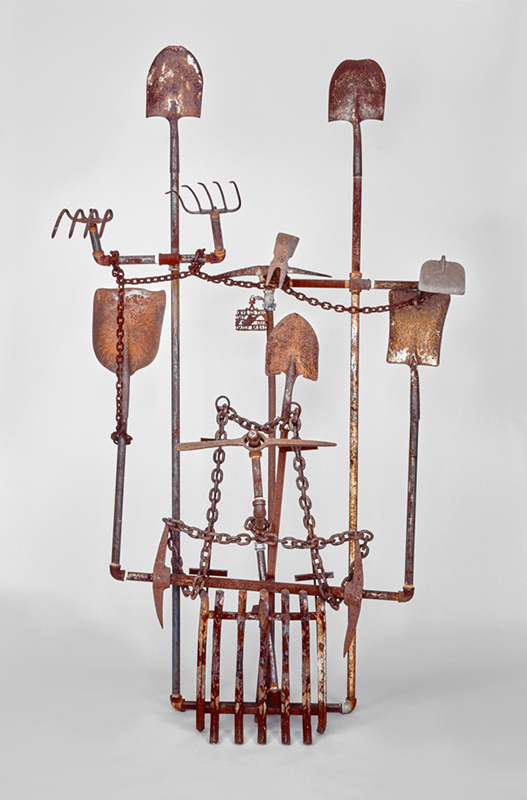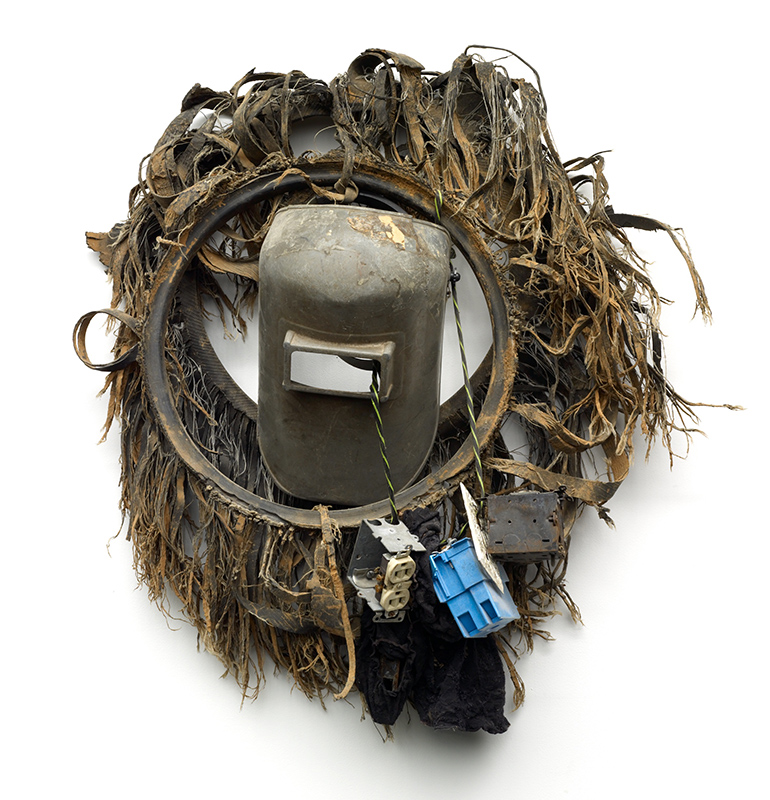Assemblage & Resilience: Techniques of Art Making in the Souls Grown Deep Foundation Collection
by John-Duane Kingsley
Within the canon of western art history, the technique of assemblage, or creating art out of disparate quotidian objects to form a collage, manifests in works by Cubist, Futurist, and Dada artists of the early 20h century. These schools of art intentionally incorporate objects to add texture or dimension while also critiquing the perceived value and conventional beauty of fine art through the inclusion of a ready-made industrial object or material. Formally trained artists like Picasso and Duchamp stand in stark contrast to self-trained artists falling under the label of folk art, whose utilization of assemblage is typically aligned with socioeconomic conditions that result in a reliance on discarded and repurposed objects. Within these circumstances, vernacular objects like lawn chairs, house paint, and broken tools become symbols of creativity and resilience amidst hardship rather than the intentional critique of art making. This is especially poignant among self-taught African American artists collected by the Souls Grown Deep foundation, an organization that houses the largest collection of Black artists in the Southeastern United States. The organization’s mission is to advocate for “Black artists from the South and their inclusion in the canon of American art history and fosters economic empowerment, racial and social justice, and educational advancement in the communities that gave rise to these artists.” In keeping with this mission the foundation recently donated a collection of 57 works of art across media and 20 quilts to The Metropolitan Museum of Art, thus becoming the largest single gift of Black art donated to the museum.
Within this collection, the poignancy of Thornton Dial’s imagery emerges as one of the strongest voices. His personal narrative is also compelling. Dial was born in Emelle, AL, near a former cotton plantation where his family worked as sharecroppers. When his family moved to Bessemer, AL, Dial noted the expressive and colorful art in the yards. He did not act on this appreciation until his retirement as a metalworker from the Pullman Steel Plant. Dial’s skills and history as a laborer infuse his work. He reflected:
“My art is the evidence of my freedom. When I start any piece of art I can pick up anything I want to pick up. When I get ready for that, I already got my idea for it. I start with whatever fits with my idea, things I will find anywhere…I only want materials that have been used by people, the works of the United States, that have did people some good but once they got the service out of them they throwed them away. So I pick it up and make something new out of it. That’s why we pick up these things. Negroes done learned how to pick up old things and make them brand-new. They had to learn them things to survive, and they done got wiser for doing, wiser by looking at the things and taking them into the mind. You call that ‘smart.’”
Dial’s creative agency and intelligence are evident in his piece entitled Strange Fruit: Chanel 42 created in 2003. The work depicts a man hanging from the neck by a television antenna that serves as a substitute for a lynching tree. The figure is formally dressed with a tie and collared shirt and below him are frayed and stained rags, a recurring motif in Dial’s work intended to illustrate the abuse of Black people throughout American history. The scene represents a particular incident when Dial appeared on the television program 60 Minutes and was subjected to patronizing treatment from the show’s hosts, who saw Dial as unsophisticated and unable to cope with the modern world. He later referred to the abuse suffered as a result of this white savior mentality as his “execution.”
Figure 1: Strange Fruit: Chanel 42, Thornton Dial, 2003. Spray can tops, clothes, wood, artificial flowers, found metal, wire, tools, oil, enamel, spray paint, and Splash Zone compound on canvas on wood. Fine Arts Museums of San Francisco. Image by Steven Pitkin/Pitkin Studios. Courtesy of Souls Grown Deep Foundation.
The material intelligence and inventiveness of Dial’s work gleaned from his experience as a skilled laborer resonates throughout the Souls Grown Deep collection, as with the work of Joe Minter. Minter, whose father was a mechanic, was raised in a family of ten and worked a series of jobs in metalwork, furniture, autobody, and construction. Minter’s relationship to labor is evident in his piece Four Hundred Years of Free Labor created in 1996. The work, comprised of metal shovels, pitchforks, and pickaxe heads bonded together by welded pipes and chains, approximates the scale of a person and thus anthropomorphizes the tools. The assemblage of tools serves as a proxy for their users, recalling the centuries of African Americans subjected to hard labor whether as slaves harvesting cotton before the Civil War or as laborers on a chain gang building roads and bridges throughout the 20th century. Minter’s selection of material makes visible this exploited labor allowing the viewer to grow in empathy and respect for this history. Of his work, Minter says:
“The whole idea handed down to me by God is to use that which has been discarded, just as we as a people have been discarded [and] made invisible. That what is invisible, thrown away, could be made into something so it demonstrates that even what gets thrown away, with a spirit in it can survive and grow. A spirit of all the people that has touched and felt that material has stayed in the material.”
The pride of heritage and the purpose of labor reflected in Minter’s work is shared by Lonnie Holley’s African Mask (2004). The piece features a welder’s mask mounted onto a shredded rubber tire whose tendrils also ensnare disassembled elements of an electrical socket. The sculpture is evocative of African tribal masquerade attire, blending the history of the African diaspora from the Atlantic slave trade with the contributions of men of African ancestry who entered the industrial workforce in the 20th century. Institutionalized racism within Southern labor unions prevented training for African Americans in more skilled professions like welding, making upward mobility difficult to achieve.
Despite these limitations, Holley remains optimistic about the future and the power of creativity within the artists he’s met through Souls Grown Deep. He says:
“I think Souls Grown Deep should be considered a guidebook of the future, that our children could see this book, research these materials, learn the style and conditions, take it back to their classrooms, introduce it to their teachers, and their teachers will take them to the archives of museums, or libraries, or whatever they need to do their studies… We need to think about the wonderful future. I may not see it, and we may not see it in our lifetime, the greatness of these efforts, but it will be known. I say never underestimate what a child can do for another child. Never underestimate what an adult can do for another adult. We got to be able to seek and find the efforts, the methods, that’s going to make our place a better place.”
John-Duane Kingsley is a contributing writer for The Decorative Arts Trust Bulletin. You can read more of his work at www.dandycraft.org.
About The Decorative Arts Trust Bulletin
Formerly known as the "blog,” the Bulletin features new research and scholarship, travelogues, book reviews, and museum and gallery exhibitions. The Bulletin complements The Magazine of the Decorative Arts Trust, our biannual members publication.










